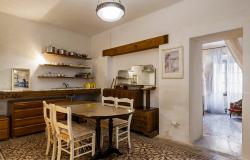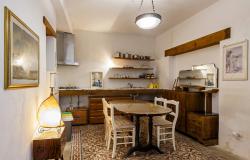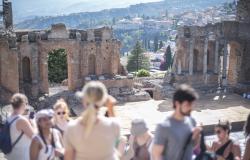Words and Pictures by Pat Eggleton
If you have visited Sicily you may have seen cheerfully painted wooden carts at tourist sites and you will certainly have seen replicas of the carts on sale as souvenirs. But have you ever looked closely at a traditional cart or wondered how they came to be so richly decorated?
 It was the Ancient Greeks who brought the concept of a simple, rectangular cart with two wheels to Sicily and carts of this type can be seen in the Roman mosaics at Piazza Armerina. Carts that we would recognise today are mentioned in the Chronicles of the Aragonese Federico III of Sicily. The carts were pulled by horse in cities and over flat areas but donkeys and mules were used for rougher terrain.
It was the Ancient Greeks who brought the concept of a simple, rectangular cart with two wheels to Sicily and carts of this type can be seen in the Roman mosaics at Piazza Armerina. Carts that we would recognise today are mentioned in the Chronicles of the Aragonese Federico III of Sicily. The carts were pulled by horse in cities and over flat areas but donkeys and mules were used for rougher terrain.
The decoration of the vehicles did not begin until the second half of the nineteenth century and at first they were painted to protect them from the sun. Early designs were based on blue colours and depicted religious themes but gradually the decoration became more and more ornate and bright colours began to appear, most famously the red and yellow of the flag of Palermo.
 Wood carvers, metal workers and painters all worked on the carts and there are some rare examples of “arte povera” [“poor people's art”] in which carving, not painting, forms the decoration.
Wood carvers, metal workers and painters all worked on the carts and there are some rare examples of “arte povera” [“poor people's art”] in which carving, not painting, forms the decoration.
Most of the carts, however, were painted and the themes ranged from the religious to the historic to the folkloric. One of the most frequently depicted legends is the story of Roland, who becomes Orlando in Sicily. The legend is based on the epic poem ”Orlando Furioso” by Ariosto, which in turn is based on the French “Chanson de Roland”.
 As craftsmen and painters vied with one another to produce elaborately decorated carts, the carts became status symbols, just like our cars today. But they were always working vehicles and often their use and provenance can be ascertained from their shape and colours:
As craftsmen and painters vied with one another to produce elaborately decorated carts, the carts became status symbols, just like our cars today. But they were always working vehicles and often their use and provenance can be ascertained from their shape and colours:
Most carts from the Trapani area were squarer and were used for the transport of salt. They had higher wheels than other carts to keep the body of the cart out of the water when it crossed marshy areas.
Most Palermo carts were slightly wider and were used for the transport of grapes. Other carts were used to transport grain.
Other carts were used to transport grain.
Carts from Catania are more rectangular and the base colour tends to be red whilst Agrigento carts are the most elaborately decorated of all.
Sadly, the carts are now only to be seen at tourist sites or as museum pieces and the art of decorating them is dying out, not helped by situations like this. The cart painter in this story, Franco Bertolino, painted 500 carts and was inspired to decorate one with scenes from the life of Paolo Borsellino, the anti-Mafia judge murdered in 1992. This is the last historic event to have been depicted in this way.
A famous cart painter whose work is being preserved is Raffaele La Scala, who was born in Comiso [Ragusa] in 1924.
He began learning to paint carts at the age of five and opened his own workshop in Grammichele at the age of 17. After being called up he returned to Comiso to support his family and there some visitors from Agrigento saw his work and suggested he move to the larger city. He did so and painted carts there for twenty years.
 As the use of motor vehicles increased, Raffaele La Scala witnessed the slow death of the art of cart painting but he made at least thirty new carts and performed maintenance work on many others. When the “ape” [three-wheeled small motorised vehicle] came in he also decorated some of these.
As the use of motor vehicles increased, Raffaele La Scala witnessed the slow death of the art of cart painting but he made at least thirty new carts and performed maintenance work on many others. When the “ape” [three-wheeled small motorised vehicle] came in he also decorated some of these.
Fifteen years after the birth of his first grandson, Raffaele La Scala took up his craft again because he wanted his family to have pieces to remember him by. Now his son curates a collection of five carts, totally made and decorated by hand, three small carts and a carriage.
Raffaele La Scala has a facebook page and you can arrange a guided visit of his exhibition through his website.
Parts from traditional Sicilian carts have become collectors' items and sometimes in an antique shop you will find a plaque from a cart displaying the painter's name. A friend of mine uses a piece from a cart for hanging coats:

The carts represent the creativity and sense of joy of the Sicilian people and everyone who owns a piece from a cart today displays it in their home with pride.
Some places where you can see Sicilian carts are:
 Donnafugata Castle [Ragusa Province].
Donnafugata Castle [Ragusa Province].
Museo Pitrè [Palermo] – currently closed for restoration but due to reopen in 2011.
Museo del Carretto Siciliano di Terrasini [Palermo Province] – part of the Museo Civico di Terrrasini
Museo dell'Arte del Carretto Siciliano [Catania]
At the Almond Blossom Festival in Agrigento.












